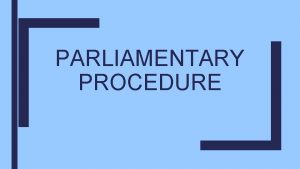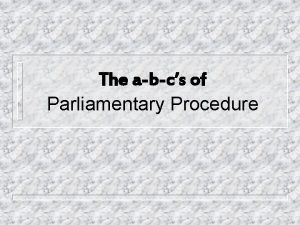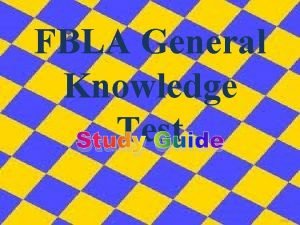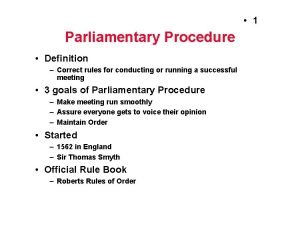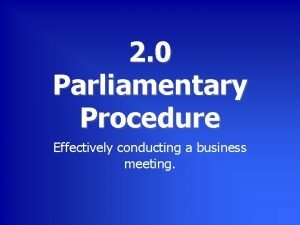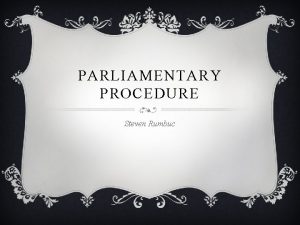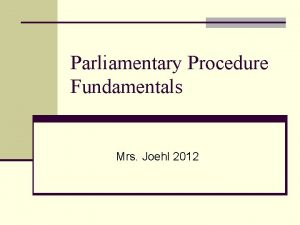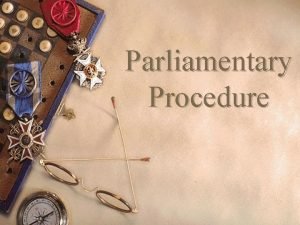Parliamentary Procedure Lesson II Development of Meeting Skills








- Slides: 8

Parliamentary Procedure: Lesson II Development of Meeting Skills

Copyright © Texas Education Agency, 2017. These Materials are copyrighted © and trademarked ™ as the property of the Texas Education Agency (TEA) and may not be reproduced without the express written permission of TEA, except under the following conditions: 1) Texas public school districts, charter schools, and Education Service Centers may reproduce and use copies of the Materials and Related Materials for the districts’ and schools’ educational use without obtaining permission from TEA. 2) Residents of the state of Texas may reproduce and use copies of the Materials and Related Materials for individual personal use only, without obtaining written permission of TEA. 3) Any portion reproduced must be reproduced in its entirety and remain unedited, unaltered and unchanged in any way. 4) No monetary charge can be made for the reproduced materials or any document containing them; however, a reasonable charge to cover only the cost of reproduction and distribution may be charged. Private entities or persons located in Texas that are not Texas public school districts, Texas Education Service Centers, or Texas charter schools or any entity, whether public or private, educational or non-educational, located outside the state of Texas MUST obtain written approval from TEA and will be required to enter into a license agreement that may involve the payment of a licensing fee or a royalty. For information contact: Office of Copyrights, Trademarks, License Agreements, and Royalties, Texas Education Agency, 1701 N. Congress Ave. , Austin, TX 78701 -1494; phone 512 -463 -7004; email: copyrights@tea. state. tx. us. Copyright © Texas Education Agency, 2017. All rights reserved. 2

Parliamentary Procedure > Obtaining the Floor Stand, address the Chair, receive recognition > Introducing Business (Making a Motion) Stand, “I move that…”, statement must receive a 2 nd, sets motion before debate, prepare for vote Copyright © Texas Education Agency, 2017. All rights reserved. 3

Rules of Debate > Every member has a right to speak on every debatable motion > All discussion pertains to the question at hand > While debate is in progress, amendments can be introduced > Debate cannot last longer than 10 minutes unless assembly votes otherwise Copyright © Texas Education Agency, 2017. All rights reserved. 4

Rules of Debate > No member can speak twice on the same motion > No member can attack or question the motives of another member > The maker of the motion, although allowed to vote against the motion, is not allowed to speak against it > The presenter of the motion may be the first person to debate Copyright © Texas Education Agency, 2017. All rights reserved. 5

Amendments > After the chair has restated a motion, the only way to change the motion would be by an amendment > Amendments are made by adding, deleting, or changing > Only two amendments may be pending on a main motion at any time (primary or secondary – or First or Second Degree) > Amendments are made in the same way as for any main motion. The secondary amendment may be made to the primary amendment > Amendments must be germane to the question under consideration Copyright © Texas Education Agency, 2017. All rights reserved. 6

Voting > A majority decides, unless special rules apply > Voice vote, unless otherwise provided for > If the presiding officer is a member of the assembly, he or she can vote as any other member does when the vote is by ballot > Any member may request a division of the assembly if there is uncertainty as to the true result of the vote Copyright © Texas Education Agency, 2017. All rights reserved. 7

Types of Votes > voice > rising vote or showing hands > call vote > ballot vote > general consent > plurality vs. majority vote > null and void > division of assembly Copyright © Texas Education Agency, 2017. All rights reserved. 8

